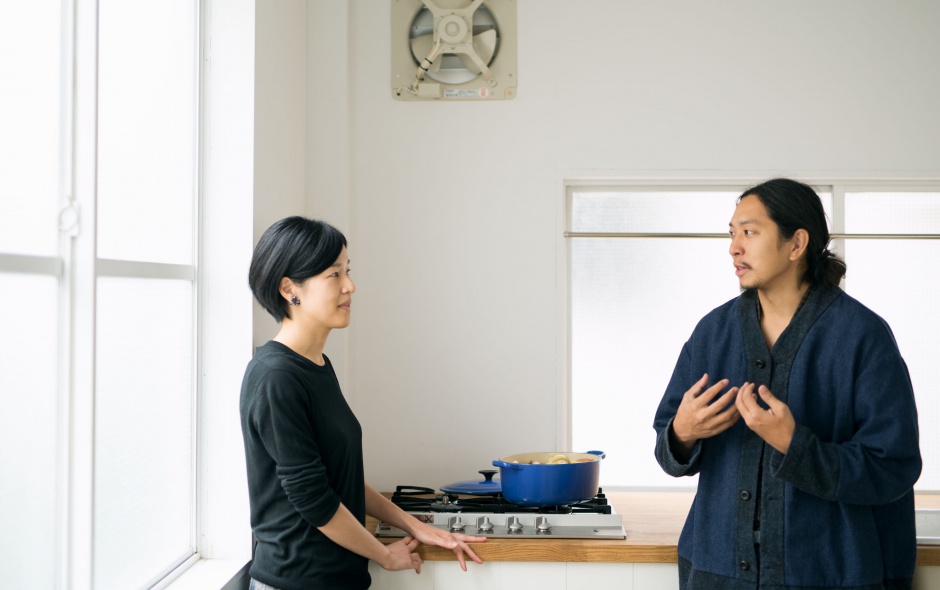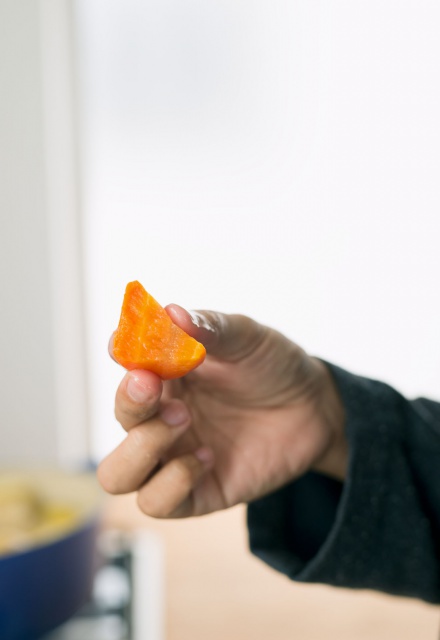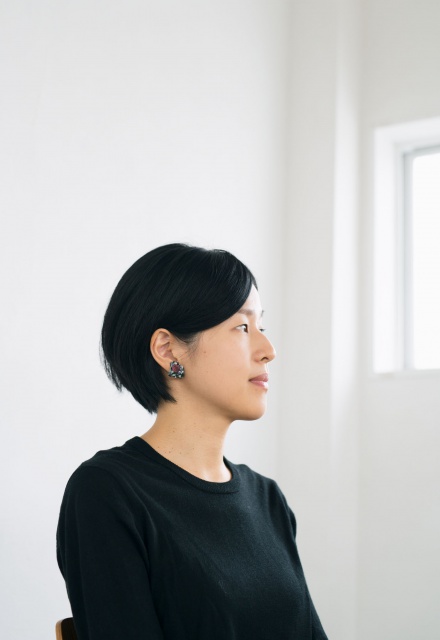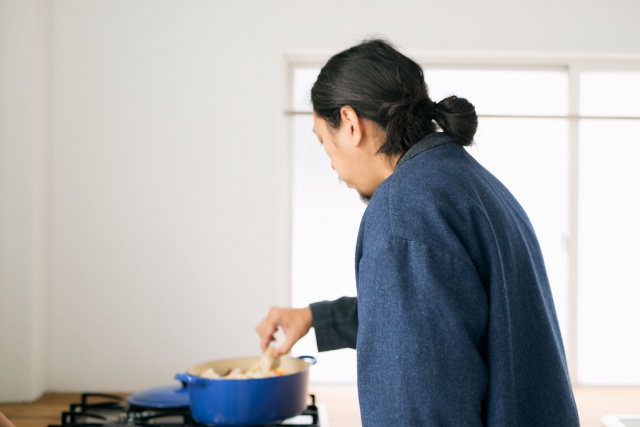vol.
015
DECEMBER
2016
vol.015 / Roundtable
The bodily senses we should trust in today
Daizaburo Sakamoto (Yamabushi, mountain ascetic) × Satoko Kobiyama (Food artist)

Daizaburo Sakamoto is a Yamabushi mountain ascetic based in Yamagata’s Dewa Sanzan mountains. Tokyo-based Satoko Kobiyama promotes “food and everything around it” under the trade name yama foods. The two find surprising things in common during a thoroughly physical Players’ Talk.
One day late at night, a pan of pot-au-feu stood in the kitchen as her family slept. She wondered what it would be like to stick her hand into the pan. Driven by a violent impulse the moment she saw the pan, Kobiyama lost no time acting on it. . . The late-night pot-au-feu incident was 20 years ago. Conversation began with the two of them putting Kobiyama’s formative food experience into practice.
Kobiyama: The moment I stuck my hand in the pot, I did have a guilty feeling that I had done something I shouldn’t have. But the feeling of guilt soon turned to pleasure. The feel and temperature of the meat in my hand, the smell reaching my nose and the flavors, the texture and temperature in my mouth when I ate it, the sounds as I bit through the meat. That was when I saw the act of eating in a new light; how sumptuous it was and how it utilizes so many senses.
Sakamoto: How old were you when you had this experience?
Kobiyama: I was at junior high.
Sakamoto: You were quite a strange junior high student (laughs).
Kobiyama: (laughing). As a result of my late-night pot-au-feu incident I got really interested in everything surrounding the experience and act of eating. There was no stopping me between meals. I used to wonder what it would be like to eat bread from a plate lying down, or think so much about exactly what food I was in the mood for and how I was going to eat it that some days I conversely couldn’t eat a thing. The way you experience the flavor of even the same food changes according to factors at that time — your physical state and mood, whether you use a spoon or chopsticks, whether you eat it with your hands, who you eat it with. . . I mean that eating is not just about putting food in your mouth. You’re also ingesting your surroundings and the contextual mood. All of it becomes nutrition and part of you. That intense experience was the starting point for what I do now.

Sakamoto: To put it another way, the act of eating links the inner world of the self with the outer world. My child was born about seven months ago now, and when I see it being reared on my wife’s breast milk I think that by taking its mother into its body this way, the child’s life is connected to hers. Since we’re on the subject, breasts are also sexual objects. Sex is inextricably linked to eating, as we can see in the expression, “I could just eat her up.” When you think of it this way eating is a very sensual and raw thing.
Kobiyama: In contemporary society, eating is being turned into something clean and beautiful, but as you say eating is by nature an extremely raw act. I personally like to offer food that evokes the human instinct to eat things you’ve caught yourself and the action of that moment, not that politely-served food which is one step away from what I’m talking about. So although I am a person who makes food, I don’t feel I’m the so-called normal type of chef. Because I always feel this somewhere inside, I don’t know what to tell people when they ask me what I call myself.
Sakamoto: Aren’t you a shaman?
Kobiyama: A shaman?!
Sakamoto: I think you might be a bit taken aback by the word, but originally the magic of the shaman meant the concept and act of controlling nature and the environment in order to fulfill a wish of some kind. Since cooking also harvests the bounty of nature, by manipulating this as a cook you distribute the power of nature to people. That’s why I think what you do and shaman’s magic aren’t that far apart.
Kobiyama: So from today my title is “shaman” (laughs).

Sakamoto: There’s also a shamanistic side to the Yamabushi, you know. The people who originally lived on the Japanese archipelago believed deities and spirits existed in nature. Yamabushi culture and the Shugendo religion came from an amalgamation of various beliefs like the Buddhism that was later brought to Japan, Shinto, and the way of Yin and Yang. Do you know the word “Hijiri”? It refers to someone who knows the workings of the sun, moon and stars, and in the past Yamabushi mountain ascetics were also called Hijiri. Since farming began, it had been vital to know the calendar in order to know when to sow seeds and harvest crops, so for a long time the Hijiri Yamabushi connected nature and people in a shamanistic way.
Kobiyama: What originally got you into the world of Yamabushi mountain asceticism?
Sakamoto: It was really by chance. I heard through a friend that people were doing ascetic training on Mount Haguro in Yamagata in summer. It sounded interesting, so through simple curiosity I went to Yamagata, and that was my first connection with Yamabushi culture.
Kobiyama: What aspect of Yamabushi culture were you particularly curious about?
Sakamoto: From when I was a child I used to make things and I loved drawing pictures. Yamabushi developed from the animist cultures of the Jomon period. When I discovered the Yamabushi were closely involved with traditional Japanese arts and accomplishments as well, for the first time I felt closer to the Yamabushi. I wanted to learn from Yamabushi culture how our ancestors living in the Japanese archipelago engaged with the object of their beliefs i.e. nature, and what customs, habits and culture this created. So ten years ago I headed for Haguro to train in mountain asceticism.

Kobiyama: I went to Yamagata just the other day. I climbed Mount Haguro, and from the moment I set foot at the base, I began to feel a sort of stirring through my whole body. . . . I can’t make any comparisons because I don’t normally climb mountains, but for the first time I wondered if this was what it’s like to feel awe.
Sakamoto: There have been temples and shrines on Mount Haguro for about 1400 years. When you consider how many people have come and gone to the mountain over that time with so many different thoughts and feelings, it’s enough to make you shiver slightly. Incidentally, people come to the world of Yamabushi for a variety of reasons, so in the past it was taboo to ask someone why they became a Yamabushi. But whatever your situation may be, every one is the same on the mountain. It was thought that the mountain was another world beyond the control of the powers that be, so Yamabushi would hold their own funeral, and because they considered themselves deceased when they came to the mountain, nothing was made of their deeds in secular society.
Kobiyama: The Dewa Sanzan mountains to me mean Mount Haguro, Mount Gassan and Mount Yudono. Because people from Yamagata really do maintain Yudono shrine’s famous “don’t ask don’t tell” secrecy, I was all the more curious to know what’s there.
Sakamoto: Don’t you think forbidding talking is an important value? Since ancient times, talking around something when discussing something important, rather than talking about the heart of the matter, has been at the root of Japanese culture. The point is that no words can describe things with impeccable accuracy. The instant you describe Mount Yudono, something important crumbles away. People of old understood the nature of “don’t ask don’t tell” so they didn’t readily discuss things that were truly important. The quintessence of Japanese culture is spoken of without words.



